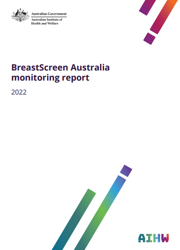Summary
BreastScreen Australia is the national breast cancer screening program. It aims to reduce illness and death from breast cancer through an organised approach to the early detection of breast cancer, using screening mammography to detect unsuspected breast cancer in women. Early detection provides an opportunity for early treatment, which can reduce illness and death. Women aged 40 and over are eligible for free mammograms every 2 years.
This report is the latest in the annual BreastScreen Australia monitoring report series. It presents the latest data available for participants aged 50–74.
Breast cancer is the most common cancer affecting Australian women
Breast cancer is the most common cancer diagnosed in Australian women. In 2018, 11,401 new cases of invasive breast cancer were diagnosed in women aged 50–74, equivalent to 340 new cases per 100,000 women in the population.
Incidence rose from around 200 new cases per 100,000 women aged 50–74 in the years before BreastScreen Australia began in 1991, to 300 cases per 100,000 in 2000. Between 2013 and 2018, incidence remained at around 320 new cases per 100,000 women.
Breast cancer is the second most common cause of cancer‑related death in Australian women, behind lung cancer. In 2020, 1,517 women aged 50–74 died from breast cancer, equivalent to 43 deaths per 100,000 women in the population.
Breast cancer mortality has decreased since BreastScreen Australia began—from 74 deaths per 100,000 women aged 50–74 in 1991 to around 40 deaths per 100,000 since 2014.
Half of targeted women participate in BreastScreen Australia
Around 1.8 million participants aged 50–74 participated in BreastScreen Australia in 2019–2020, equivalent to a crude participation rate of 50% of the population. The age-standardised participation rate remained between 53% and 54% from 2014–2015 to 2018–2019 and has decreased in 2019–2020 due to the impact of the COVID-19 pandemic from March 2020.
A small proportion of participants are recalled for further investigation
In 2020, 11% of participants who screened for the first time, and 4% of participants attending a subsequent screen, had a screening mammogram result indicating they should be recalled for further investigation. These rates are similar to those in 2019.
More than half of the cancers detected by BreastScreen Australia are small
Small breast cancers (≤15 mm in diameter) tend to be associated with more treatment options, lower morbidity and improved survival. In 2020, 45% of breast cancers detected in participants attending their first screen, and 62% of breast cancers detected in those attending subsequent screens, were small. In comparison, just 28% of breast cancers detected outside BreastScreen Australia are small (AIHW 2018).
Around two in five Aboriginal and Torres Strait Islander women participated in BreastScreen Australia
Participation in BreastScreen Australia for Aboriginal and Torres Strait Islander women aged 50–74 was 36% in 2019–2020, compared with 49% for non-Indigenous women. Indigenous women aged 50–74 had a lower incidence rate of breast cancer than non-Indigenous women (284 compared with 314 new cases per 100,000 women). Indigenous women aged 50–74 had a higher mortality rate than non-Indigenous women, (45 compared with 40 new deaths per 100,000 women).
Terminology
This document uses the terms ‘participant’ and ‘participants’ when referring to data collected under BreastScreen Australia. These data are not restricted by sex or gender, with all participants in breast screening included in these data.
For breast cancer screening data, ‘participant’ or ‘participants’ is defined as a person having breast tissue that is suitable for breast cancer screening and who has engaged with the Service and/or SCU through a screening and/or assessment appointment or visit.
Screening participants may include women, transgender men, transgender women, non-binary people or other gender diverse people. State and territory BreastScreen services provide advice on BreastScreen and gender, including whether screening for breast cancer may benefit transgender women, transgender men, non-binary, and gender diverse people.
This document uses the term 'women' to mean ‘female' when referring to cancer incidence data and cancer mortality data, as these data sources are based on sex assigned at birth. However, it should be noted that some people may not identify with this term.
Impact of COVID-19 on BreastScreen Australia services
The COVID-19 pandemic has affected many areas of people’s lives, including their access to and use of health services, such as cancer screening programs.
Many of the performance indicators in this report are reported for 2020, which coincided with the start of the COVID-19 pandemic in Australia. To protect clients, staff, and the community from the risk of COVID-19, BreastScreen Australia services were suspended nationwide from 25 March 2020. The suspension was lifted around a month later for most services, but a staged approach was introduced with longer appointment times and precautionary measures to ensure the safety of clients and staff. The rate at which BreastScreen services could resume was affected by jurisdictional social distancing and infection control guidelines and requirements. Most BreastScreen services stayed open, with these additional precautionary measures, for the remainder of the year despite additional lockdowns and increasing numbers of cases of COVID-19.
Summary
Data at a glance
1. Introduction
2. BreastScreen Australia
3. Performance indicators
Recruitment
- Performance indicator 1: Participation
- Performance indicator 2: Rescreening
Screening
- Performance indicator 3: Recall to assessment
Assessment
Diagnosis
- Performance indicator 4: Invasive breast cancer detection
- Performance indicator 5: Ductal carcinoma in situ (DCIS) detection
- Performance indicator 6a: Interval cancers
- Performance indicator 6b: Program sensitivity
Outcomes
- Performance indicator 7a: Invasive breast cancer incidence
- Performance indicator 7b: Ductal carcinoma in situ (DCIS) incidence
- Performance indicator 8: Mortality from breast cancer
Appendix A: Supporting data tables
Appendix B: BreastScreen Australia information
Appendix C: Data sources
Appendix D: Classifications
Appendix E: Statistical methods
End matter: Acknowledgments; Abbreviations; Symbols; Glossary; References



